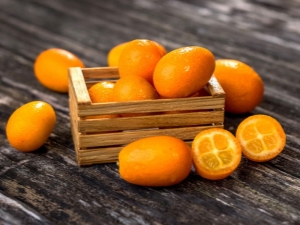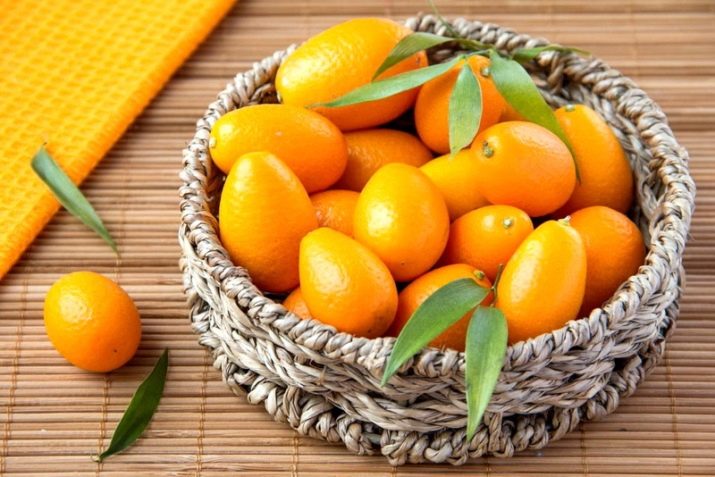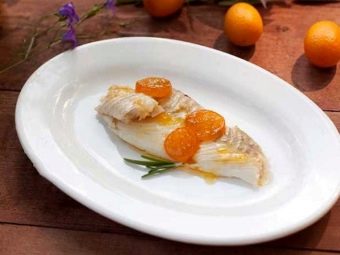How to eat kumquat?

The developed trade between different regions of the world leads to the fact that today our everyday life includes products that no one had really heard about 10 or 20 years ago in these parts.These products include, for example, kumquat, an exotic ingredient in oriental dishes, which can already be enjoyed in Japanese, Chinese and Vietnamese restaurants.
However, given the growing popularity of kumquat, some large supermarkets began to buy it for sale to ordinary consumers, because now the question is often not even what it is, but how to use an exotic fruit for a change of its own diet.
general description
Whatever one may say, for the majority of our compatriots the kumquat still remains a rare wonder, about which not everyone has heard. Even those who have tried this fruit, know very little about it, because a small educational program will not hurt.
Let's start with the description of the fetus. Kumquat is a citrus that tastes decently reminiscent of tangerines of sweet varieties, but the dimensions of this fruit are much more modest - it never reaches the size of a tangerine, and it also has a characteristic shape resembling a slightly elongated egg. The flesh of the fruit is divided into slices, of which there are no more than 5.
Such a miracle grows on small trees no more than 4 meters high, sometimes also on bushes. As befits a citrus plant, kumquat loves a warm climate and does not grow to the north of the subtropics, although some experiments on grafting kumquat twigs to a shrub called “pontirus” growing in the edges with a climate similar to ours have achieved success.
In general, gardeners note that the resettlement of a plant in a cold environment unusual for it, significantly affects the taste of fruits, which greatly lose their sweetness, but here it should be understood that the selection work has just begun.
If we talk about the natural habitat, then initially kumquat comes from southeastern China - in particular, those regions that border Vietnam. The advantages of culture were first appreciated by residents of neighboring countries, and then by Europeans, so you should not think that all these fruits come to us from China - probably, many of them came from much closer to the Mediterranean. It should be noted that this culture today is very popular as an ornamental houseplant, so theoretically it can be found in absolutely any country.
Composition
Fresh kumquat contains about 80% of water, so it is not surprising that its caloric content is low - it is about 71 kcal. It should be noted that after most types of cooking, much of the moisture is lost, and the concentration of calories increases, because in dried form, for example, the energy value of kumquat can reach much more significant 250 kcal. Consequently, fresh fruit does not pose a threat to the figure, but in a dried one it can harm it.
The characteristic sourness and the very fact of the attitude to citrus indicate that the fruit is rich in vitamin C - this is its main useful component. However, this list of vitamins present here does not end there - A, E and some vitamins of group B are also presented.
If we talk about trace elements, then the most valuable kumquat high potassium content. Calcium, magnesium and sodium cannot be distinguished among the other substances, and zinc and iron, which are present in small quantities, complete the picture. The picture of the composition will be incomplete if we exclude from it polyunsaturated fatty acids, monosaccharides and essential oils. Separately, it should be said that kumquat does not contain nitrates, which are supersaturated with modern soils, which is very good for the human body.
Benefit and harm
There is a kumquat not only for the sake of a very pleasant taste, but also because of the many beneficial properties for the organism. This product is popular in traditional Chinese medicine, therefore, it should be at least briefly to highlight its main benefit for a person:
- due to the high content of vitamin C, kumquat helps to strengthen the immune system and fight the causative agents of any ailments;
- the same substance is a very effective cure for a hangover, because it is enough to eat a few kumquats so that you can feel better in a matter of minutes;
- the ability of the fetus to actively remove toxins from the body can also be used in pregnancy-specific toxicosis, unless allergies are diagnosed;
- the composition of the fruit allows for the splitting of fats by an accelerated pattern, and therefore reduces the load on the gallbladder and liver.
Among other things, by-products from kumquat in the form of, mainly, oils, can be used as a separate medicine or as a component of various cosmetic recipes.
Unfortunately, there is no such food, which would be guaranteed harmless to everyone, and kumquat, of course, is no exception. There are situations in which to eat it in any form would be wrong.
- Citrus allergies also spread to kumquat, therefore, if you can not feast on oranges, you can not even try this fruit. At the same time, allergy is also possible in the kumquat itself, because for the first time it is eaten by no more than half of the fruit, carefully monitoring the reaction of the body. People who are prone to allergic manifestations are recommended to eat no more than a couple of pieces at a time. Contrary to general recommendations for women, they are also usually advised not to abuse kumquat.
- It should be remembered that vitamin C, which is very abundant in kumquat, is ascorbic acid. Like any other acid, this substance irritates the walls of the stomach, and if the health of the digestive system is not okay, you should not aggravate the ulcer or gastritis by using such a delicacy.
- Kumquat refers to products that have a pronounced diuretic effect - not for nothing that it is so effective for removing toxins. Consequently, the fruit creates an extra burden on the kidneys and urinary system, and if problems are observed there, they can only get worse. If there are stones, the use of the fruit is completely prohibited, otherwise damage to the inner walls of the paths or their complete blockage may occur.
- Contrary to the significant content of ascorbic acid, the taste of kumquat is rather sweet, and this indicates a significant content of sugars. There are not so many of them, and they are relatively harmless, because in general, fruit are not contraindicated for diabetics. Another thing is that people with such a diagnosis should use kumquat carefully, in moderation and under constant control of blood sugar levels.
Terms of Use
There is no need to eat too much kumquat (like any other product), we have already spoken, as well as the fact that you should start with small portions - it remains to decide how to eat this fruit correctly.
For a start, the citrus that cannot be eaten fresh is bad - this statement fully applies to kumquat. At the same time, such a fruit has a characteristic feature - it is never cleaned, but eaten directly with the skin, since the latter, being very thin, is not inferior to the pulp either in taste or in benefit. The fruits are simply washed whole and so eaten, although for convenience they can be cut in half.
The rule of using kumquat with peel applies not only to the unique dessert presented only by this fruit, but also to dishes that can be prepared from a fresh variety. So, a very tasty juice from kumquat is also pressed out without cleaning the pulp of the skin - the resulting liquid can be drunk both in pure form and as part of cocktails, and can be added to ice cream. In the same form, the fruit is present in any dishes, regardless of the method of their preparation.
With all the usefulness of fresh kumquat, you should not overeat - an adult, even in the absence of an allergy, should not exceed the daily rate of 300 grams, and for children this rate is reduced threefold.
Unlike most of our usual citrus fruits, kumquat is not only eaten with sandpaper, but also used to make dried fruits.For our edges, such a product is still very rare, but if you suddenly come across, know that it is also used raw, as well as in the composition of dishes, and also with peel.
Dried kumquat can be consumed in many different ways, but very often it is directly related to beverages. In Europe, such a product is considered a chic addition to many cocktails, martinis are often complemented with them to add an exotic flavor and flavor to the drink.
But at home, this fruit is used for beverages that cause less harm to the body - for example, grinding crushed dried kumquat and adding such powder to tea brewing is a typical phenomenon, resulting in a natural flavored tea with additional beneficial properties. You can not add the fruit directly to the drink, using it as a dessert served to tea - in this case, the fruit is usually dipped in honey or molasses.
Unfortunately, dried kumquat, like any other dried fruit, per 100 grams of weight contains much more sugars and other substances as opposed to missing water, therefore the same diabetics such a product is contraindicated - He is able to provoke a very sharp jump in blood sugar. Even if a person is not threatened with diabetes, one should still refrain from overuse of such a dessert, since the caloric content as a result of drying has increased several times, and with such delicacies it is not surprising to gain excess weight as soon as possible.
If we talk about the possible culinary use in our country, then the most popular recipe, perhaps, will be an ordinary compote. Such a drink is characterized by a bright citrus flavor, and for more piquancy it is often added a little more cinnamon.
For our fellow citizens, the preservation of any fruit is also a very common habit, so even for Kumquat, recipes have already been invented. From this fruit, you can cook a stunning jam with a rich taste and aroma, which can be eaten without anything or added as a filling in baking. An alternative method of preparing kumquat is pickling whole fruits with cloves, cinnamon and cardamom - a savory snack will turn out well and surprise guests much more than the traditional tomatoes in this role.
We have already appreciated the combination of citrus flavor with meat or other dishes, but so far they are usually limited to adding a slice of lemon or orange, but the kumquat sauce can become a real culinary breakthrough. Naturally, the fruit essence of the main raw material allows us to focus on the sweet notes that will help the resulting gravy to become a very interesting addition to desserts - the resulting thick mass can be used as topping for ice cream or curd mass.
No matter how you use kumquat fruits, remember that your dish is exotic and its taste, especially at first, will not necessarily please the guests and the chef himself. However, the use of such ingredients implies a mandatory warning to all those present in order to avoid unexpected allergies.
For information on how to cook kumquat jam, see the following video.































